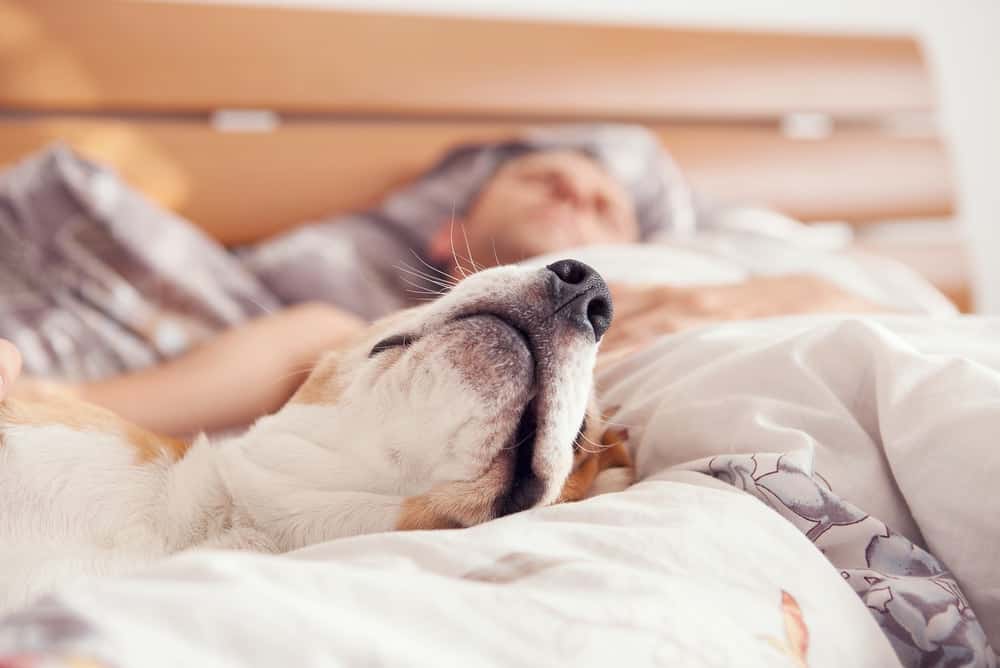“This post contains affiliate links, and I will be compensated if you make a purchase after clicking on my links.”
By Amelia Palmer
When a dog suffers from sleep apnea, their breathing repeatedly stops and starts while deep in slumber. This interruption is caused by a blockage in the airway that prevents them from inhaling properly. Allergies, obesity, or obstructions in the nasal cavity or throat are the most common causes.
As sleep apnea leads to a dog’s breathing being compromised, it can be incredibly serious. In a worst-case scenario, it will lead to death.
If you’re concerned that your dog may be a sufferer, take a look at the 10 signs you need to watch out for:

1. Does Your Dog Snore Loudly?
If your dog snores, this could mean that he or she is suffering from sleep apnea. Certain brachycephalic breeds such as the Shih Tzu, Pug, and English Bulldog have flatter snouts. As a result, they have a short breathing passage, and this makes them predisposed to snoring. But even dogs with long snouts can sore if they have an obstruction in their airway.
2. Does Your Dog Gasp When They Sleep?
Sleep apnea occurs if the air flowing to the dog’s lungs is interrupted while they’re sleeping. As a result of not getting enough oxygen, they will suddenly gasp for air.
3. Does Your Dog Choke When They Sleep?
If your dog chokes while asleep, this is a major red flag. Choking signs are gasping, gagging, or drooling, and they may look different from what you’d observe in a person.
If you see your dog displaying any choking symptoms, you should perform the Heimlich Maneuver on them:
- Take hold of your dog’s back paws and hold these up in the air so that his front paws touch the ground.
- Wrap your other arm around his abdomen and push hard below his ribs five times.
- Sweep your dog’s mouth with your finger and then set him down on all fours.
- Finally, give him five sharp taps between his shoulder blades.
4. Is Your Dog Overweight?
Sleep apnea is caused by the soft tissue at the back of your throat collapsing – this applies to dogs and humans. When we talk about ‘soft tissue’ at the back of your throat, we’re talking about your tongue, soft palate, and adenoids.
So, if you suspect that your dog is suffering from this condition and they’re overweight, put them on a calorie-controlled diet. Your local vet will be able to design a diet that’s right for your dog and can recommend food that will promote weight loss.

The Association for Pet Obesity Prevention has published a list of ideal weights for dogs, depending on their breed. For example, the association recommends that dachshunds weigh between 8 and 10 lbs. It suggests larger weights for bigger dogs such as Labradors (65 – 80 lbs.) and German Shepherds (75 – 95 lbs.).
5. Does Your Dog Suffer From Allergies?
Dogs can have up to 300 million scent receptors in their nose, while the average human only has 100 million. This gives dogs – especially bloodhounds – an incredible sense of smell that allows them to pick up on a vast number of scents.
This keen sense of smell puts a dog at risk for developing allergies where their throat swells up, which serves to block air from getting into their lungs. Unfortunately, this also promotes the development of sleep apnea.
6. Does Your Dog Have A Short Snout?
As we mentioned earlier, there are certain breeds of dogs that have short snouts. These snouts have usually been bred shorter, and flat-faced dogs may suffer from genetic conditions, brachycephalic syndrome, and associated sleep disorders being just some of them.
Because of their shortened snouts, their air passages are shorter as well. This shorter distance makes it much easier for impediments to develop in these passages, promoting the development of sleep apnea.
7. Is Your Dog Irritable?
If your dog displays signs of irritability, this could be a sign that they’re not getting enough proper rest. Sleep apnea stops dogs from getting enough quality shut-eye as they’re regularly awoken. If you suspect this is the case, book a veterinary consultation.
If the vet doesn’t diagnose sleep apnea, but the irritability remains, make sure that your dog is getting enough exercise or that they are not suffering from anxiety. If they’re burning off excess energy and still testy, you can opt for calming treats or explore other treatment options.

8. Is Your Dog Always Tired?
If you often see your dog listlessly sitting in their bed and they are not up to doing much, this could also be a sign that they are suffering from the condition and not getting enough sleep.
As we said in the point above, if you see your dog displaying symptoms such as these – and you want to rule out sleep apnea – take them to your local vet for a check-up.
9. Does Your Dog Sleep During The Day?
If you often see your dog curled up in their basket during the day, consider this an alarm bell. While sleeping during the day is not unusual, if this is all they’re doing, it could indicate an issue.
10. Is Your Dog Constantly In Contact With New Stimuli?
If your dog is continuously coming into contact with new places, people, or things, they may react badly to environmental factors. Different grasses in parks, washing powders, perfumes, or cleaning products can all trigger reactions.
Like an allergy, a reaction to stimuli will create congestion in their nasal passages. This can dry out the nose and mouth or lead to an excess of mucus. Either way, this can result in an airway obstruction and cause sleep apnea.
Sleep apnea can be very difficult to detect in dogs. If you suspect they may be suffering from this condition, you need to take action. Observe their sleep and behavioral patterns and if you see anything worrying, take them to the vet.
With a background in holistic medicine, Amelia Palmer is an editor and writer at MDRN CBD covering a variety of topics. When she’s not writing, you can find her volunteering at her local animal shelter or at the dog park with her two rescues, Bandit & Belle.












